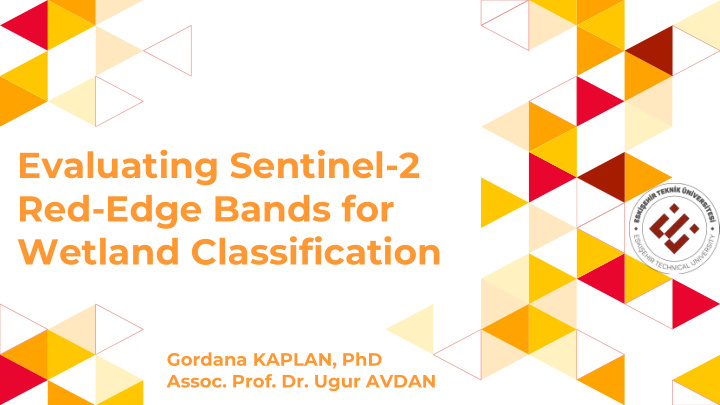



Evaluating Sentinel-2 Red-Edge Bands for Wetland Classification Gordana KAPLAN, PhD Assoc. Prof. Dr. Ugur AVDAN
Contents ◂ Introduction ◂ Aim of Study ◂ Data and Methods ◂ Results ◂ Discussion ◂ Conclusion 2
Introduction Wetlands are one of the most significant ecosystems on Earth, as they provide a number of ecological services and a number of valuable functions. Due to the high spatial heterogeneity and temporal variability, wetlands are one of the most difficult ecosystems to observe using remote sensing data. The biggest challenge in the wetland mapping is separating the wetland class from the upland classes like forest and agricultural areas. 3
Wavelength Wavelength Wavelength Wavelength Resolution Resolution Landsat-8 Central Central Sentinel-2 Bands (μm) (μm) (μm) (μm) (m) (m) Bands “ Aim of the Study Band 1 - Band 1 - Coastal 0.443 0.421-0.457 60 Coastal aerosol 0.443 0.435-0.451 30 aerosol Band 2 - Blue 0.482 0.452-0.512 30 Band 2 - Blue 0.494 0.439-0.535 10 Band 3 - Green 0.561 0.533-0.590 30 Band 3 - Green 0.560 0.537-0.582 10 Band 4 - Red 0.655 0.636-0.673 30 Band 4 - Red 0.665 0.646-0.685 10 Band 5 Red Edge 0.704 0.694-0.714 20 Band 6 Red Edge 0.740 0.731-0.749 20 With the additional Sentinel-2 vegetation Band 7 Red Edge 0.781 0.768-0.796 20 Band 8 - NIR 0.834 0.767-0.908 10 red-edge bands, an improvement of the Band 8A - vegetated classes classification is expected. Vegetation Red 0.864 0.848-0.881 20 Band 5 - NIR 0.865 0.851-0.879 30 Edge Band 9 - Water The aim of the study is to investigate the 0.944 0.931-0.958 60 vapour influence of the red-edge bands for wetland Band 9 - SWIR Band 10 - SWIR 1.375 1.338-1.414 60 Cirrus 1.373 1.363-1.384 30 Cirrus classification. Band 6 1.609 1.567-1.651 30 Band 11 - SWIR 1.612 1.539-1.681 20 Band 7 2.201 2.107-2.294 30 Band 12 - SWIR 2.194 2.072-2.312 20 Band 8 0.590 0.503-0.676 15 4 Band 10 10.895 10.60-11.19 100-30 Band 11 12.005 11.50-12.51 100-30
Study Area ◂ The central Anatolian part of Turkey has a continental climate with very high temperatures during the summer days, and cool nights, and cold and hard winters. Central Anatolia is generally a region with low rainfall. The annual rainfall varies between 300-500 mm. When it comes to the distribution of precipitation according to the seasons, the summer season is generally dry, autumn is rainy, while in spring and winter there are heavy rains. 5
Data and Methods Sentinel-2 (10 August 2017) Two datasets • Without red-edge (DS-1) • S2 all bands (DS-2) Object-based classification SVM classification Classes: Bogs Swamps
Results The visual comparison of the results indicates that low accuracy in classifying Swamp areas in the first dataset, while the accuracy of the second class, Bog, has shown that Bogs are being accurately classified, but their readability is significantly low. 7
Results DataSet-1 DataSet-2 Swamps Bogs Swamps Bogs User Accuracy User Accuracy 46% 68% 73% 67% 96% Producer Accuracy Producer Accuracy 50% 96% 80% 8
Disccusion Although the red-edge bands did not affect the bog ◂ classification, their influence in the swamp classification was very significant. The producer accuracy of the second dataset in the swamp class was 30% higher, and the user accuracy was about 27% higher than the first data set. The red-edge bands helped in separating the marsh ◂ from the green dense agricultural areas. For the investigation of the radar bands over partially ◂ decayed vegetated wetland areas such as bogs, further investigations are needed. 9
Conclusion The influence of the red-edge bands over Swamp class showed improvement of the results for more than 27%. The complex structure of wetlands requires their classification in more than one class. While both bog and swamp are wetland areas, they have very different characteristics and different dataset should be used for their accurate mapping. Radar data have stronger backscatter signal from wetter surfaces than the one from drier surfaces. Thus, according to the results presented in this study, data obtained from Sentinel-2 are more suitable for marsh classification. For future studies, we recommend investigating the influence of different data for different wetland classes, as well as multi-temporal data as an addition to the presented datasets in this study. 10
Thank you for your attention! For any questions please contact us: Gordana KAPLAN, PhD kaplangorde@gmail.com Assoc. Prof. Dr. Ugur AVDAN uavdan@eskisehir.edu.tr
Recommend
More recommend